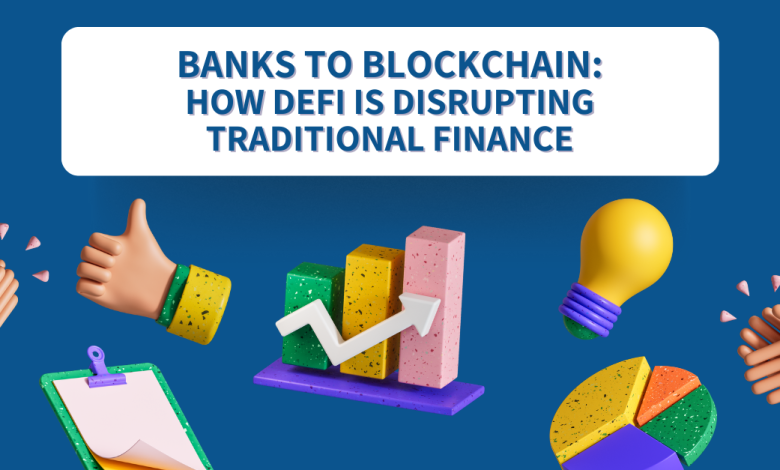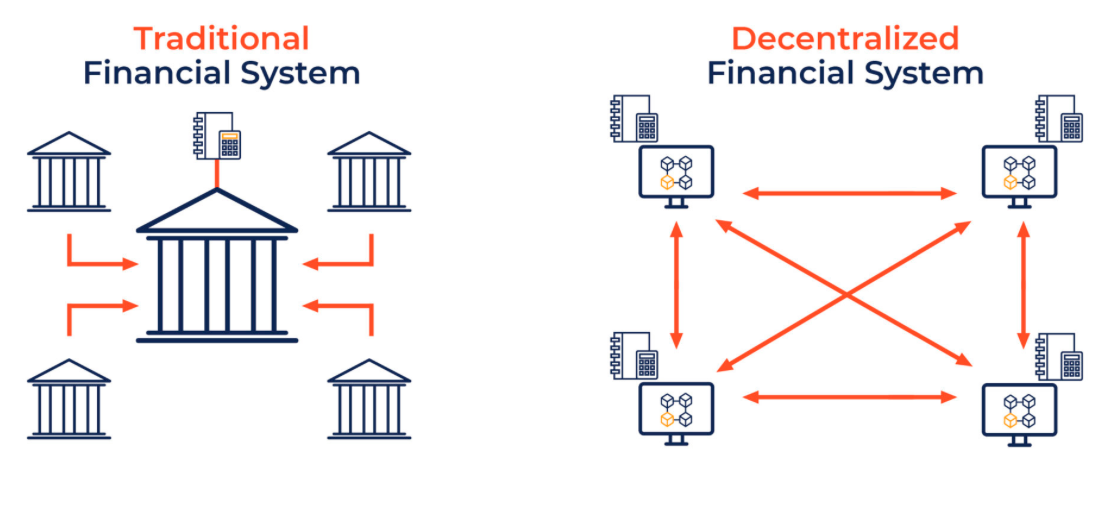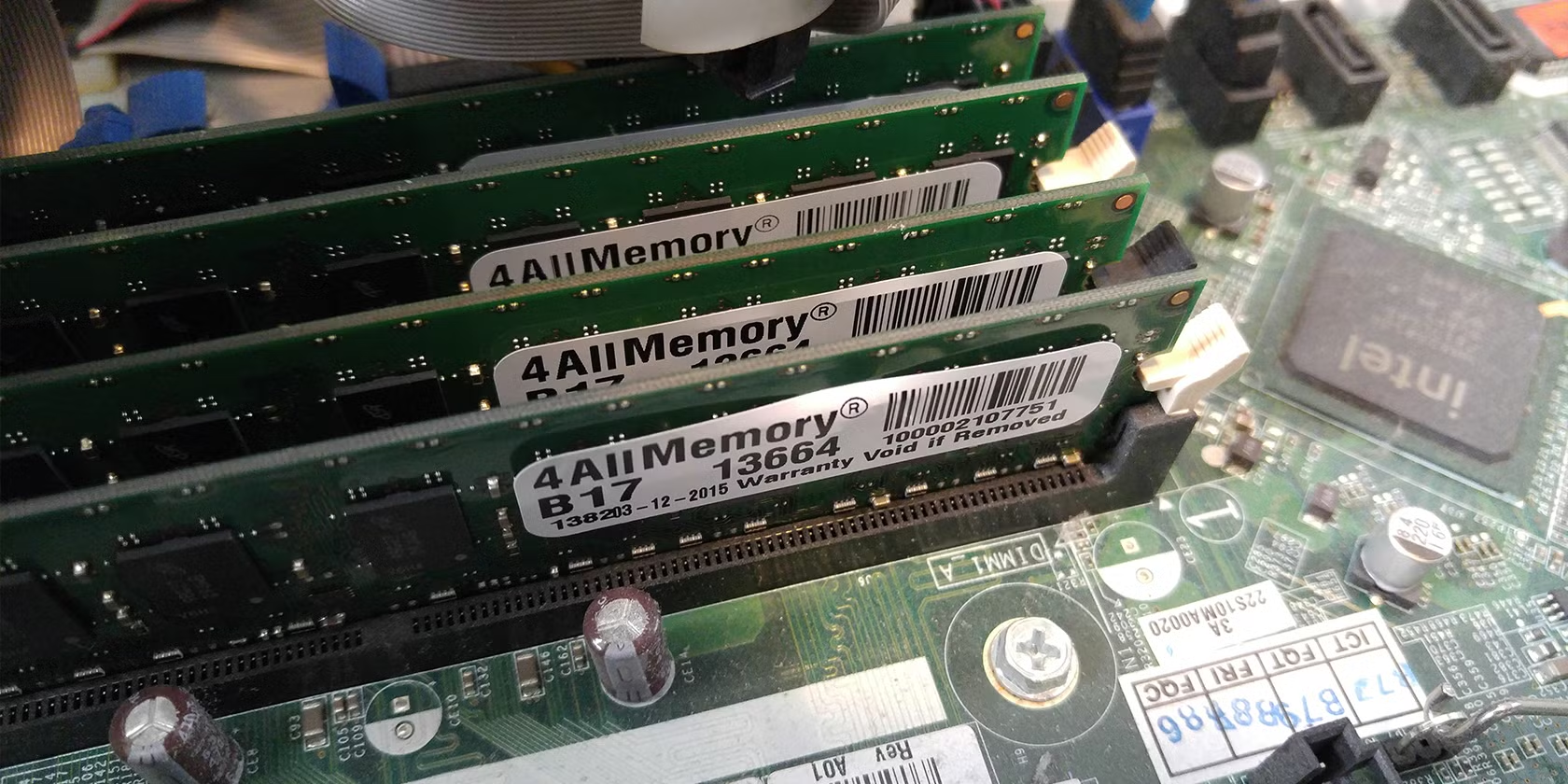DeFi: Disrupting Traditional Finance

What is DeFi?
Decentralized Finance, or DeFi, is a new financial system built on blockchain technology. Unlike traditional finance, DeFi operates without centralized institutions like banks or brokers. Instead, it relies on smart contracts and decentralized networks to enable financial transactions. These transactions include lending, borrowing, and trading, all executed without intermediaries.
DeFi aims to create an open and accessible financial ecosystem. Anyone with internet access can participate, making it inclusive and global. As DeFi grows, it poses a significant challenge to traditional finance, offering a new way to handle financial activities.
How DeFi Differs from Traditional Finance
DeFi and traditional finance serve the same basic functions, but they operate in fundamentally different ways.
1. Decentralization
In traditional finance, banks and institutions control transactions and hold customer funds.It removes the need for these intermediaries. Instead, it uses smart contracts, which are self-executing agreements coded onto the blockchain. This setup allows people to transact directly with each other, reducing the need for trust in a central authority.
2. Transparency
Traditional finance operates within closed systems. Information about transactions and decisions often remains inaccessible to the public. In contrast, It offers complete transparency. All DeFi transactions are recorded on a public blockchain, viewable by anyone. This transparency builds trust and accountability.
3. Accessibility
It provides financial services to anyone with an internet connection, unlike traditional finance, which often has geographic or socioeconomic barriers. Users do not need bank accounts, credit scores, or even government-issued IDs to participate. This accessibility can empower individuals in underbanked regions.
4. Control and Ownership
In traditional finance, users entrust their money to banks or brokers. DeFi users have full control over their assets, secured by private keys. This shift puts ownership back in the hands of individuals, reducing reliance on intermediaries and enhancing financial independence.

Key Components of DeFi
It consists of various financial products and services. Here are the main components that drive the DeFi ecosystem:
1. Decentralized Exchanges (DEXs)
DEXs allow users to trade cryptocurrencies directly with each other, without an intermediary. They operate using smart contracts, which match buyers and sellers automatically. Unlike centralized exchanges, DEXs do not hold user funds, reducing the risk of hacking or fraud.
2. Lending and Borrowing Platforms
It enables lending and borrowing through smart contracts. Users can lend their crypto assets to earn interest or borrow by providing collateral. These platforms operate without banks, creating an open market where rates are set by supply and demand. Examples include Compound and Aave, which offer users more flexibility and potentially higher returns.
3. Stablecoins
Stablecoins are cryptocurrencies designed to maintain a stable value, usually pegged to a currency like the U.S. dollar. They provide stability in the volatile crypto market, making it easier to transact or store value. Stablecoins are essential for DeFi, as they allow users to avoid price fluctuations during transactions.
4. Yield Farming
Yield farming allows users to earn rewards by staking or lending their assets within it platforms. In return, users receive interest or tokens as rewards. Yield farming has become popular in DeFi, attracting users looking to maximize returns on their crypto holdings. However, it carries risks, especially if the platform or smart contract has vulnerabilities.
5. Insurance Protocols
It insurance provides coverage for risks associated with DeFi activities, like smart contract failures or hacking. These protocols help protect users’ investments, building confidence in DeFi. By offering insurance, DeFi can attract more users and expand its reach.
Advantages of DeFi over Traditional Finance
It offers several benefits that challenge the traditional financial system.
1. Lower Costs
Without intermediaries, DeFi significantly reduces transaction fees. Traditional banks and brokers charge high fees for services like transfers, loans, and trading. It automates these processes, minimizing fees and making financial services more affordable.
2. Faster Transactions
In traditional finance, transactions can take days to settle, especially across borders. DeFi transactions are processed quickly, sometimes in minutes. This speed is especially valuable for international transfers and time-sensitive transactions.
3. Global Accessibility
It breaks down geographic barriers. People from any part of the world can access DeFi services, promoting financial inclusion. This accessibility can empower underserved populations, providing them with financial tools previously out of reach.
4. Transparency and Trust
It operates on blockchain, which records all transactions publicly. This transparency reduces fraud and builds trust among users. Unlike traditional finance, It doesn’t rely on the reputation of a bank or financial institution. Instead, the technology itself ensures trust.
5. Innovation and Flexibility
DeFi allows for greater innovation by removing the constraints of traditional finance. Developers can create new financial products quickly and adapt them to meet user demands. This flexibility allows It to evolve rapidly, offering users a wider range of financial tools.
Risks and Challenges of DeFi
Despite its benefits, It comes with its own set of risks and challenges.
1. Security Risks
Smart contracts are susceptible to bugs or vulnerabilities. Hackers can exploit these weaknesses to steal funds, causing users to lose money. Although DeFi platforms undergo security audits, risks remain, especially for newer projects.
2. Regulatory Uncertainty
It operates in a regulatory gray area. Governments worldwide are trying to understand and regulate DeFi, but policies vary. Unclear regulations can make it difficult for users and developers to navigate legal requirements, potentially limiting DeFi’s growth.
3. Volatility
The crypto market is highly volatile, and DeFi is no exception. While stablecoins offer some stability, other assets can fluctuate wildly. This volatility affects borrowing, lending, and investments, creating challenges for users seeking stable returns.
4. Complex Interfaces
DeFi platforms can be challenging to use for those unfamiliar with blockchain or crypto technology. The complex user interfaces and technical requirements make it hard for beginners to participate. Improving accessibility is crucial for DeFi to reach mainstream users.

The Future of DeFi and Traditional Finance
DeFi is still in its early stages, but its impact on traditional finance is growing. As DeFi matures, it could reshape the financial landscape. However, it’s unlikely to replace traditional finance entirely. Instead, DeFi and traditional finance may coexist, each serving different purposes.
In the future, traditional financial institutions may adopt DeFi concepts. Some banks are already exploring blockchain technology to improve efficiency. A hybrid approach that combines DeFi’s innovation with the stability of traditional finance could offer the best of both worlds.
For DeFi to thrive, it needs to overcome its challenges. Improved security, clearer regulations, and user-friendly interfaces are essential. As DeFi addresses these issues, it could become a mainstream financial solution, accessible to everyone.
Conclusion: DeFi’s Role in Disrupting Finance
It is challenging traditional finance by offering a decentralized, transparent, and accessible financial ecosystem. By removing intermediaries, It empowers individuals, providing them with control over their financial assets. Its innovative nature allows for rapid adaptation, enabling users to access a range of financial services without banks or brokers.
While It offers exciting opportunities, it also faces risks. Security vulnerabilities, regulatory challenges, and volatility are significant concerns. Addressing these issues will be crucial for DeFi’s long-term success.
As DeFi evolves, it may integrate with traditional finance, creating a more inclusive global financial system. With its potential to disrupt and transform, It is shaping the future of finance, making it more open, efficient, and accessible for all.




